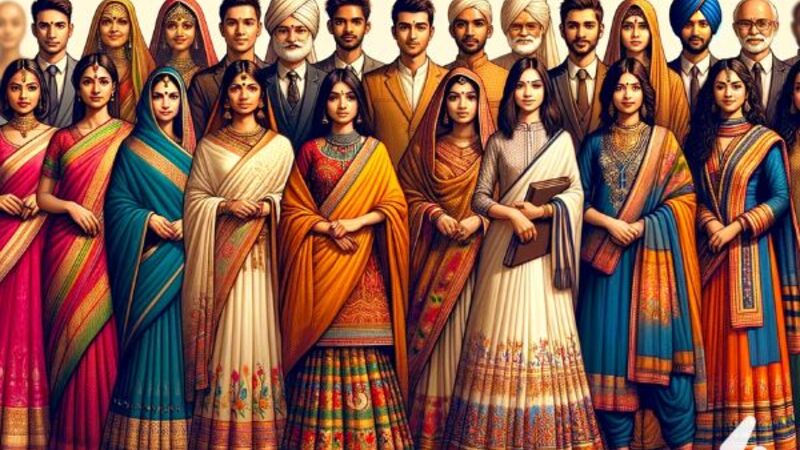India, known for its rich cultural heritage, boasts a kaleidoscope of traditions, each reflecting its own unique charm and history. One of the most visually striking aspects of Indian culture is its diverse range of clothing traditions. From the vibrant hues of Rajasthan to the intricate weaves of Varanasi, Indian clothing encapsulates centuries of tradition, innovation, and symbolism.
In this article, we embark on a journey to explore the multifaceted world of Indian clothes, delving into its regional variations, historical significance, and contemporary relevance.
The Evolution of Indian Clothing
To understand the diversity of Indian clothing, it’s essential to delve into its evolutionary journey. Indian attire has been shaped by a myriad of influences, including historical, social, and environmental factors. The earliest evidence of clothing in India dates back to the Indus Valley Civilization, where archaeological findings depict draped garments made from cotton and silk. Over the centuries, successive waves of migration, trade, and colonialism have left an indelible mark on Indian clothing, giving rise to a tapestry of styles and techniques.
Regional Variations
North India: A Symphony of Colors and Embroidery
In North India, clothing traditions are characterized by their opulence and intricate craftsmanship. The region is renowned for its vibrant textiles, elaborate embroideries, and ornate embellishments. One of the most iconic garments is the saree, a length of fabric draped elegantly around the body, often adorned with intricate patterns and motifs. In states like Rajasthan and Punjab, traditional attire such as the lehenga and sherwani are favored for weddings and festive occasions, featuring elaborate embroidery and embellishments.
South India: Graceful Drapes and Timeless Elegance
In contrast, South Indian clothing exudes a sense of understated elegance and grace. The sari reigns supreme here as well, albeit draped in a distinct style known as the nivi drape. Fabrics like silk and cotton dominate, with motifs inspired by nature and mythology adorning the borders and pallu. In states like Tamil Nadu and Kerala, traditional attire such as the mundu and veshti for men and the kasavu saree for women are still popular, reflecting the region’s rich cultural heritage.
East India: Weaves of Tradition and Heritage
The eastern part of India is celebrated for its rich tradition of handloom weaving, with states like West Bengal and Odisha producing some of the finest textiles in the country. The sari takes on a different avatar here, with the tant saree and kantha saree being highly prized for their exquisite craftsmanship. Men often don the dhoti or panjabi kurta, while women opt for the elegant tant saree or baluchari saree, each woven with stories of tradition and heritage.
West India: Timeless Classics and Contemporary Flair
In the western region of India, clothing traditions blend timeless classics with contemporary flair. The ghagra choli of Gujarat and the bandhani sarees of Rajasthan exemplify the region’s love for vibrant colors and intricate tie-and-dye techniques. Meanwhile, cities like Mumbai have embraced a more cosmopolitan style, with fusion wear like the Indo-western ensemble gaining popularity among the urban youth.
Historical Significance
Indian clothing is not merely about aesthetics; it also holds profound historical and cultural significance. Throughout history, attire has been used to denote social status, religious affiliation, and regional identity. The dhoti and saree, for example, have been worn for millennia and are imbued with symbolism and tradition. Similarly, the turban worn by Sikh men and the burqa worn by Muslim women carry deep religious and cultural significance, serving as visible markers of identity and belonging.
Contemporary Relevance
Despite the influx of Western fashion and globalization, traditional Indian clothing continues to thrive, evolving with the times while retaining its core essence. Designers like Sabyasachi Mukherjee and Anita Dongre have played a pivotal role in revitalizing traditional crafts and techniques, bringing them to the forefront of the global fashion stage. Moreover, initiatives like the “Handloom Day” and “Crafts Revival Week” aim to promote indigenous textiles and support local artisans, ensuring that India’s rich sartorial heritage continues to flourish for generations to come.
Conclusion
In conclusion, the diversity of Indian clothing traditions is a testament to the country’s rich cultural tapestry and storied past. From the intricate weaves of Benarasi silk to the vibrant hues of Kanchipuram silk, each garment tells a story of tradition, innovation, and identity. As India continues to embrace modernity while honoring its heritage, its clothing traditions serve as a vibrant reminder of the country’s enduring spirit and timeless elegance. So, the next time you drape a saree or don a kurta, remember that you’re not just wearing a piece of fabric but carrying on a legacy that spans centuries—a legacy of beauty, diversity, and cultural pride.
